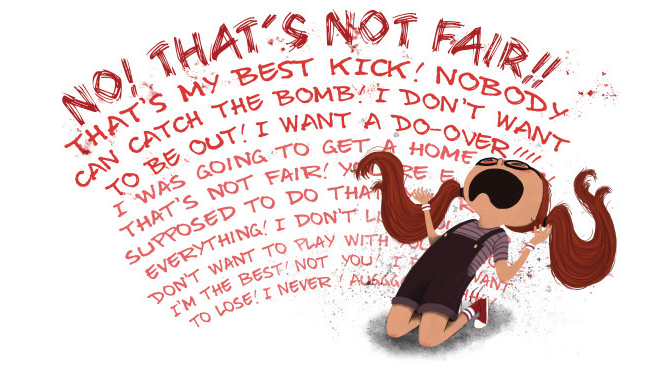Ella McQueen, Kickball Queen: Q&A with Beth Mills

by Carol Hinz, editorial director of Millbrook Press and Carolrhoda Books
Do you know any elementary-age kids who are obsessed with kickball? I happen to have two of them living in my very own home! Yet despite kickball’s popularity, it doesn’t show up much in picture books. So I was pretty much smitten with author/illustrator Beth Mills’s debut picture book from the moment I laid eyes on it. Beth was kind enough to answer some questions about her book and share some incredible sketches and color studies so all of us can get a peek at how this book came to be.
Q: Where did the idea for Ella McKeen, Kickball Queen come from?
A: The idea really started with Ella’s character. I came across this fabulous photo of a little girl in overalls; her hair was done up in the two longest, most luxurious pigtails I’d ever seen. I wanted to draw that hair in motion! I spent a day doodling the girl, showing her jumping, doing cartwheels, running, etc. As I drew her, I imagined her personality. I thought she’d be spunky, quick-tempered, competitive – a little bit of a handful, to be honest, but determined to do her best and honest with herself. In one of those last early doodles of her, I drew her enthusiastically booting one of those red recess balls, and Ella the Kickball Queen was born.
This is the character sheet that eventually grew from those doodles:

Q: As an author/illustrator, do you start by thinking about visuals or about the words? Or some combination of the two?
A: I’m definitely a visuals-first person. When I’m thinking about a new story, I usually have a “key image” in my head – one idea for a spread (that may or may not make it out of my head) that the rest of the story falls around. For Ella McKeen, Kickball Queen, it was the tantrum. I had sketches for Ella’s meltdown well before I’d written any of the manuscript. I knew that visual would be a huge part of the story before I’d nailed down exactly what that story was.
Q: The key conflict in this book has to do with super-competitive Ella dealing with the arrival of new student Riya, who is her equal at kickball. Girls are often pressured to be “nice” under all circumstances, but this story ends with Ella and Riya being more friendly rivals than true friends. (This is one of the things I love about the book, because it feels so authentic!) What was your thought process about how you wanted the book to end?
A: Thank you! I was striving for authenticity. Childhood social ties can be so messy! There is that underlying pressure to “be friends with everyone”- and kids should be friendly, gracious, inclusive, and kind with each other – but kids know as well as everyone else that you’re just not going to click with everyone. I wanted to show a dynamic that falls into that “friendly not friends” area.
Another motivating factor was wanting Ella McKeen, Kickball Queen to stand out from the plethora of wonderful “enemies to friends” books out there. I wanted to do things a little differently. I wanted to leave some space for the reader to think about the relationship between Ella and Riya and imagine where they could go from the end of the book. Can Riya catch the Zinger? Would Ella be a gracious winner? What does Riya do when she loses? I think it’s fun to think about their ongoing rivalry and how it could develop into a very special friendship (or not).
Q: Can you describe your process for creating the fabulous illustrations in this book?
A: The illustrations were all digitally painted in Photoshop, but I started the process with good old pencil and paper.
I did between 20-50 thumbnails for each illustration – really fast, really small, really rough sketches. I picked the few I liked the most and used those to make slightly bigger, slightly cleaner sketches. Here are the cleaned-up sketches for the tantrum page:

I took my strongest sketch, imported it to Photoshop, blew it up to about ¾ of full size, cleaned it up, and added value and some detail, making corrections or adjustments along the way. This “final sketch” was the part of the process that took the longest for me – I wanted to work out any issues with the illustration before investing lot of time on it. All of the final sketches were reviewed by the Art Director, Danielle Carnito, who had several excellent suggestions that made the illustrations better. Here’s the final sketch for the tantrum page:

While working on the final sketches, I did a few color studies as well to decide on a palette. I usually do the color studies on just one or two sketches – that’s enough for me to have an idea of how the whole will look. Here are the color studies I did (featuring a spread that did not make it into the final book):



Finally, using the color comp as a guide, I painted over the final sketch in Photoshop, using my iPad Pro and a variety of digital brushes. And voila! A finished illustration!

Thank you SO much to Beth for sharing the story behind this book! Happy reading (and kickball-playing), everyone!
—
Comments
Thanks for sharing, Beth Mills. I enjoyed reading about your process :>)